And now for some background information on China's two latest additions to UNESCO's World Heritage list, the Huashan Rock Paintings and the Shen'nong'jia Nature Reserve. The imprints of the Huashan rock paintings can be found by revisiting one of the most memorable moments of the 2008 Beijing Olympics Games.

Huashan Rock Paintings
For those who watched the Beijing Olympics Games' opening ceremony, this may ring a bell. However, few know that the symbols on the scroll come from the Huashan Rock Paintings. The paintings can be traced back as early as the Spring-Autumn and Warring States Periods or about 2500 years ago, yet the stunningly bright red color is still as vivid today.
A total of 4500 images were created on the cliff by the Zuo River, by ancestors of the Zhuang ethnic people, betwee 2500 years and 1800 years ago. The collosal rock paintings span over 105 kilometers, with a high concentration in areas where the terrain is the most jagged. The paintings are usually drawn between 15 to 100 meters and as much as 130 meters above water, a daunting task for these Zhuang people at the time.
"The images feature mostly people that measure between 20 cm and 358cm. The median measures between 70 to 150 cm," said Zhu Qiuping, director of Bureau of Cultural Heritages, Ningming County.
The composition usually consists of a main character in a frog-like pose, surrounded by a group of people. This appears to corroborate the belief that the paintings describe scenes of sacrifice with the frog serving as a totem of the ancient Luoyue people, the ancestor of the modern day ethnic Zhuang people. In some of the paintings, people, sometimes accompanied by dogs, carry knives or swords and sometimes drums, and their heads are accessoriezed with ornements, further suggesting of sacrificial practices.
The unique language, milieu, and the collosal scale of these paintings have made the Huashan paintings once of a kind in China and the world.
Meanwhile, a nature reserve of a forestry district in China has also made it as a UNESCO World Heritage site. The Shen'nong Jia Forestry District is named after the legendary emperor Shennong, with the suffix "jia" meaning "ladder", as the vicinity contains some of Hubei's highest mountains. The zone also includes conservation areas like the Shennongjia National Nature Reserve, which is now a World Heritage Site and is already a part of UNESCO's World Network of Biosphere Reserves.















